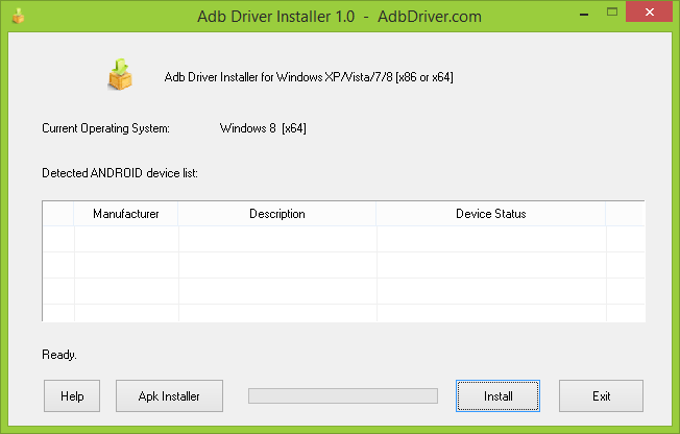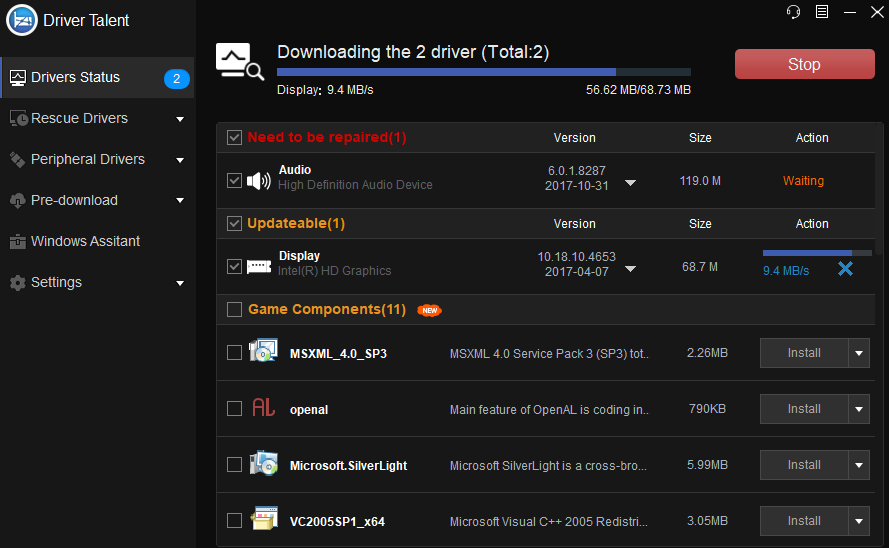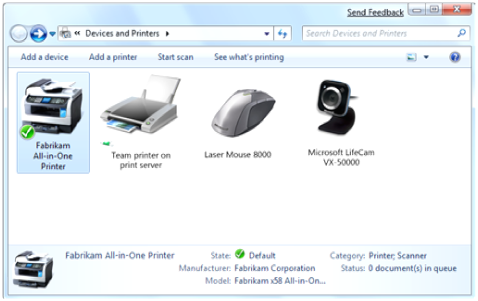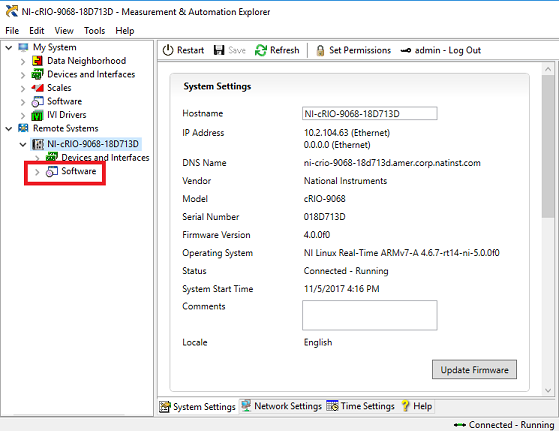- Find your phone. Probably it will be located in other devices.(If you have installed any drivers previously and wanted to update it should be named as “Android Composite ADB Interface” and follow the same further process) Right-click on it and select update driver software. Click Browse my computer for driver software and click next.
- An INF for a device of this class installs no device driver(s), but instead specifies the features of a particular monitor to be stored in the registry for use by drivers of video adapters. (Monitors are enumerated as the child devices of display adapters.).
Multi-Function Station (Including driver of 'Printer', 'Scanner' and 'PC FAX') Download the file below to the specified folder on your PC's hard disk,for example C: TEMP. Multi-Function Station will be extracted from the compressed file of.exe. Double click on, then double click on Install.exe, and follow the instructions.
If you're writing a Windows device driver for a specific category of device, you can use the following list to select the right pre-defined values to use for the Class and ClassGuid entries in the Version Section of the driver's INF file.
Note
If you're looking for info on reserved classes and GUIDs, see System-Defined Device Setup Classes Reserved for System Use.
To see how these entries appear in an INF file, check out cdrom.inf in the Windows driver samples repo.
Values in the list can be used to install device drivers on Windows 2000 and later, unless specially noted.
Note
If you're looking for info on troubleshooting a problem with a CD or DVD drive, see The CD drive or the DVD drive does not work as expected.
Device categories and class values
Battery Devices
Class = Battery
ClassGuid = {72631e54-78a4-11d0-bcf7-00aa00b7b32a}
This class includes battery devices and UPS devices.
Biometric Device
Class = Biometric
ClassGuid = {53D29EF7-377C-4D14-864B-EB3A85769359}
(Windows Server 2003 and later versions of Windows) This class includes all biometric-based personal identification devices.
Bluetooth Devices
Class = Bluetooth
ClassGuid = {e0cbf06c-cd8b-4647-bb8a-263b43f0f974}
(Windows XP SP1 and later versions of Windows) This class includes all Bluetooth devices.
Camera Device
Class = Camera
ClassGuid = {ca3e7ab9-b4c3-4ae6-8251-579ef933890f}
(Windows 10 version 1709 and later versions of Windows) This class includes universal camera drivers.
CD-ROM Drives
Class = CDROM
ClassGuid = {4d36e965-e325-11ce-bfc1-08002be10318}
This class includes CD-ROM drives, including SCSI CD-ROM drives. By default, the system's CD-ROM class installer also installs a system-supplied CD audio driver and CD-ROM changer driver as Plug and Play filters.

Disk Drives
Class = DiskDrive
ClassGuid = {4d36e967-e325-11ce-bfc1-08002be10318}
This class includes hard disk drives. See also the HDC and SCSIAdapter classes.
Display Adapters
Class = Display
ClassGuid = {4d36e968-e325-11ce-bfc1-08002be10318}
This class includes video adapters. Drivers for this class include display drivers and video miniport drivers.
Extension INF
Class = Extension
ClassGuid = {e2f84ce7-8efa-411c-aa69-97454ca4cb57}
(Windows 10 and later versions of Windows) This class includes all devices requiring customizations. For more details, see Using an Extension INF File.
Floppy Disk Controllers
Class = FDC
ClassGuid = {4d36e969-e325-11ce-bfc1-08002be10318}
This class includes floppy disk drive controllers.
Floppy Disk Drives
Class = FloppyDisk
ClassGuid= {4d36e980-e325-11ce-bfc1-08002be10318}
This class includes floppy disk drives.
Hard Disk Controllers
Class = HDC
ClassGuid = {4d36e96a-e325-11ce-bfc1-08002be10318}
This class includes hard disk controllers, including ATA/ATAPI controllers but not SCSI and RAID disk controllers.
Human Interface Devices (HID)
Class = HIDClass
ClassGuid = {745a17a0-74d3-11d0-b6fe-00a0c90f57da}
This class includes interactive input devices that are operated by the system-supplied HID class driver. This includes USB devices that comply with the USB HID Standard and non-USB devices that use a HID minidriver. For more information, see HIDClass Device Setup Class. (See also the Keyboard or Mouse classes later in this list.)
IEEE 1284.4 Devices
Class = Dot4
ClassGuid = {48721b56-6795-11d2-b1a8-0080c72e74a2}
This class includes devices that control the operation of multifunction IEEE 1284.4 peripheral devices.
IEEE 1284.4 Print Functions
Class = Dot4Print
ClassGuid = {49ce6ac8-6f86-11d2-b1e5-0080c72e74a2}
This class includes Dot4 print functions. A Dot4 print function is a function on a Dot4 device and has a single child device, which is a member of the Printer device setup class.
IEEE 1394 Devices That Support the 61883 Protocol
Class = 61883
ClassGuid = {7ebefbc0-3200-11d2-b4c2-00a0C9697d07}
This class includes IEEE 1394 devices that support the IEC-61883 protocol device class.
The 61883 component includes the 61883.sys protocol driver that transmits various audio and video data streams over the 1394 bus. These currently include standard/high/low quality DV, MPEG2, DSS, and Audio. These data streams are defined by the IEC-61883 specifications.
IEEE 1394 Devices That Support the AVC Protocol
Class = AVC
ClassGuid = {c06ff265-ae09-48f0-812c-16753d7cba83}
This class includes IEEE 1394 devices that support the AVC protocol device class.
IEEE 1394 Devices That Support the SBP2 Protocol
Class = SBP2
ClassGuid = {d48179be-ec20-11d1-b6b8-00c04fa372a7}
This class includes IEEE 1394 devices that support the SBP2 protocol device class.
IEEE 1394 Host Bus Controller
Class = 1394
ClassGuid = {6bdd1fc1-810f-11d0-bec7-08002be2092f}
This class includes 1394 host controllers connected on a PCI bus, but not 1394 peripherals. Drivers for this class are system-supplied.
Imaging Device
Class = Image
ClassGuid = {6bdd1fc6-810f-11d0-bec7-08002be2092f}
This class includes still-image capture devices, digital cameras, and scanners.
IrDA Devices
Class = Infrared
ClassGuid = {6bdd1fc5-810f-11d0-bec7-08002be2092f}
This class includes infrared devices. Drivers for this class include Serial-IR and Fast-IR NDIS miniports, but see also the Network Adapter class for other NDIS network adapter miniports.
Keyboard
Class = Keyboard
ClassGuid = {4d36e96b-e325-11ce-bfc1-08002be10318}
This class includes all keyboards. That is, it must also be specified in the (secondary) INF for an enumerated child HID keyboard device.
Media Changers
Class = MediumChanger
ClassGuid = {ce5939ae-ebde-11d0-b181-0000f8753ec4}
This class includes SCSI media changer devices.
Memory Technology Driver
Class = MTD
ClassGuid = {4d36e970-e325-11ce-bfc1-08002be10318}
This class includes memory devices, such as flash memory cards.
Modem
Class = Modem
ClassGuid = {4d36e96d-e325-11ce-bfc1-08002be10318}
This class includes modem devices. An INF file for a device of this class specifies the features and configuration of the device and stores this information in the registry. An INF file for a device of this class can also be used to install device drivers for a controllerless modem or a software modem. These devices split the functionality between the modem device and the device driver. For more information about modem INF files and Microsoft Windows Driver Model (WDM) modem devices, see Overview of Modem INF Files and Adding WDM Modem Support.
Monitor
Class = Monitor
ClassGuid = {4d36e96e-e325-11ce-bfc1-08002be10318}
This class includes display monitors. An INF for a device of this class installs no device driver(s), but instead specifies the features of a particular monitor to be stored in the registry for use by drivers of video adapters. (Monitors are enumerated as the child devices of display adapters.)

Mouse
Class = Mouse
ClassGuid = {4d36e96f-e325-11ce-bfc1-08002be10318}
This class includes all mouse devices and other kinds of pointing devices, such as trackballs. That is, this class must also be specified in the (secondary) INF for an enumerated child HID mouse device.
Multifunction Devices
Class = Multifunction
ClassGuid = {4d36e971-e325-11ce-bfc1-08002be10318}
This class includes combo cards, such as a PCMCIA modem and netcard adapter. The driver for such a Plug and Play multifunction device is installed under this class and enumerates the modem and netcard separately as its child devices.
Multimedia
Class = Media
ClassGuid = {4d36e96c-e325-11ce-bfc1-08002be10318}
This class includes Audio and DVD multimedia devices, joystick ports, and full-motion video capture devices.
Multiport Serial Adapters
Class = MultiportSerial
ClassGuid = {50906cb8-ba12-11d1-bf5d-0000f805f530}
This class includes intelligent multiport serial cards, but not peripheral devices that connect to its ports. It does not include unintelligent (16550-type) multiport serial controllers or single-port serial controllers (see the Ports class).
Network Adapter
Class = Net
ClassGuid = {4d36e972-e325-11ce-bfc1-08002be10318}
This class consists of network adapter drivers. These drivers must either call NdisMRegisterMiniportDriver or NetAdapterCreate. Drivers that do not use NDIS or NetAdapter should use a different setup class.
Network Client
Class = NetClient
ClassGuid = {4d36e973-e325-11ce-bfc1-08002be10318}
This class includes network and/or print providers.
NoteNetClient components are deprecated in Windows 8.1, Windows Server 2012 R2, and later.
Network Service
Class = NetService
ClassGuid = {4d36e974-e325-11ce-bfc1-08002be10318}
This class includes network services, such as redirectors and servers.
Network Transport
Class = NetTrans
ClassGuid = {4d36e975-e325-11ce-bfc1-08002be10318}
This class includes NDIS protocols CoNDIS stand-alone call managers, and CoNDIS clients, in addition to higher level drivers in transport stacks.
PCI SSL Accelerator
Class = SecurityAccelerator
ClassGuid = {268c95a1-edfe-11d3-95c3-0010dc4050a5}
This class includes devices that accelerate secure socket layer (SSL) cryptographic processing.
PCMCIA Adapters
Class = PCMCIA
ClassGuid = {4d36e977-e325-11ce-bfc1-08002be10318}
This class includes PCMCIA and CardBus host controllers, but not PCMCIA or CardBus peripherals. Drivers for this class are system-supplied.
Ports (COM & LPT ports)
Class = Ports
ClassGuid = {4d36e978-e325-11ce-bfc1-08002be10318}
This class includes serial and parallel port devices. See also the MultiportSerial class.
Printers
Class = Printer
ClassGuid = {4d36e979-e325-11ce-bfc1-08002be10318}
This class includes printers.
Printers, Bus-specific class drivers
Class = PNPPrinters
ClassGuid = {4658ee7e-f050-11d1-b6bd-00c04fa372a7}
This class includes SCSI/1394-enumerated printers. Drivers for this class provide printer communication for a specific bus.
Processors
Class = Processor
ClassGuid = {50127dc3-0f36-415e-a6cc-4cb3be910b65}
This class includes processor types.
SCSI and RAID Controllers
Class = SCSIAdapter
ClassGuid = {4d36e97b-e325-11ce-bfc1-08002be10318}
This class includes SCSI HBAs (Host Bus Adapters) and disk-array controllers.
Security DevicesClass = Securitydevices
ClassGuid = {d94ee5d8-d189-4994-83d2-f68d7d41b0e6}
(Windows 8.1, Windows 10) This class includes Trusted Platform Module chips. A TPM is a secure crypto-processor that helps you with actions such as generating, storing, and limiting the use of cryptographic keys. Any new manufactured device must implement and enable TPM 2.0 by default. For more information, see TPM Recommendations.
Sensors
Class = Sensor
ClassGuid = {5175d334-c371-4806-b3ba-71fd53c9258d}
(Windows 7 and later versions of Windows) This class includes sensor and location devices, such as GPS devices.
Smart Card Readers
Class = SmartCardReader
ClassGuid = {50dd5230-ba8a-11d1-bf5d-0000f805f530}
This class includes smart card readers.
Software Component
Class = SoftwareComponent
ClassGuid = {5c4c3332-344d-483c-8739-259e934c9cc8}
(Windows 10 version 1703 and later versions of Windows) This class includes virtual child device to encapsulate software components. For more details, see Adding Software Components with an INF file.
Storage Volumes
Class = Volume
ClassGuid = {71a27cdd-812a-11d0-bec7-08002be2092f}
This class includes storage volumes as defined by the system-supplied logical volume manager and class drivers that create device objects to represent storage volumes, such as the system disk class driver.
System Devices
Class = System
ClassGuid = {4d36e97d-e325-11ce-bfc1-08002be10318}
This class includes HALs, system buses, system bridges, the system ACPI driver, and the system volume manager driver.
Tape Drives
Class = TapeDrive
ClassGuid = {6d807884-7d21-11cf-801c-08002be10318}
This class includes tape drives, including all tape miniclass drivers.
USB Device
Class = USBDevice
ClassGuid = {88BAE032-5A81-49f0-BC3D-A4FF138216D6}
USBDevice includes all USB devices that do not belong to another class. This class is not used for USB host controllers and hubs.
Windows CE USB ActiveSync Devices
Class = WCEUSBS
ClassGuid = {25dbce51-6c8f-4a72-8a6d-b54c2b4fc835}
This class includes Windows CE ActiveSync devices.
The WCEUSBS setup class supports communication between a personal computer and a device that is compatible with the Windows CE ActiveSync driver (generally, PocketPC devices) over USB.

Interface Multifunction Devices Driver Download Win 7
Windows Portable Devices (WPD)
Class = WPD
ClassGuid = {eec5ad98-8080-425f-922a-dabf3de3f69a}
(Windows Vista and later versions of Windows) This class includes WPD devices.
Android ADB Interface USB Drivers will help your Windows computer recognize your Android device. Then you can transfer files from computer to Android or even install the stock or custom ROM to your Android device. This latest driver is from the Google repository.

Step 1 — Download and extract the Android USB Driver to your PC.
Step 2 — Click Start (Windows) -> Control Panel -> Device Manager (Select Device Manager).
Step 3 — On the Device Manager window find and click on computer name to select Add legacy hardware.
Step 4 — Select Next
Step 5 — Selext Install the hardware that I manually select from a list (Advanced), and click the Next
Interface Multifunction Devices Driver Download Windows 10
Step 6 — Select Show All Devices afterward click Next button again.
Step 7 — Click the Have Disk button.
Step 8 — Click Browse button to find the extracted Android ADB Driver -> android_winusb.inf and click on Open.
Step 9 — Click OK.
Step 10 — Now select the Android ADB Interface -> click Next button.
Step 11 — Click Next button again.
Step 12 — Windows Security box will appear, to confirm whether you really want to install the Android USB Driver, so just choose the Install this driver software anyway.
Step 13 — Once you clicked the Finish button, then repeat from step 2 to choose Android Composite ADB Interface.
Step 14 - Done.
